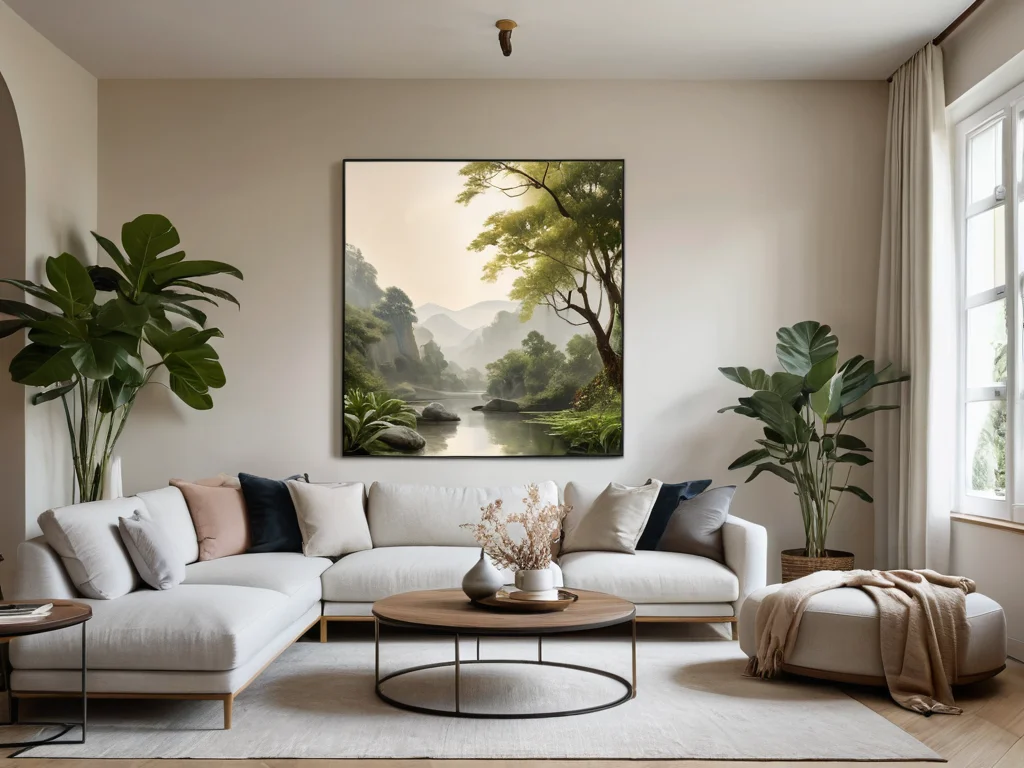Welcome to fengshuihome.ru, where we explore the ancient secrets of creating a harmonious space together. Today, we will delve into the amazing world of plant and flower images, revealing their magical power in the art of Feng Shui. You will learn how these seemingly simple decorative elements can become powerful tools for attracting luck, abundance, and well-being into your home. Prepare for a fascinating journey where we will discover how to transform your interior using the wisdom of nature.
Revitalize Your Space: Why Images of Plants and Flowers are Key to Feng Shui Harmony
For centuries, humanity has intuitively gravitated towards nature, feeling its healing and inspiring power. In Feng Shui, plants and flowers are not just decoration; they are living sources of Qi energy that can radically change the atmosphere of any space. They symbolize growth, development, renewal, and prosperity. However, it’s not always possible to have live plants: some people have allergies, some don’t have time for care, and some corners of the house are simply not suitable for live greenery due to lack of light or temperature conditions.
This is where images of plants and flowers come to the rescue. They offer a unique solution, allowing you to bring all the positive energy of nature into your home without the hassle associated with caring for live specimens. Paintings, posters, tapestries, fabric prints, or even photo wallpapers depicting lush greenery or a blooming garden carry a powerful charge of positive energy. They can:
- Bring freshness and vitality into the home: Even the dullest and most dreary space comes alive when images of blooming nature appear in it. They are believed to activate stagnant energy and bring a sense of novelty and renewal.
- Soften sharp corners and harsh lines: Modern architecture often features right angles and sharp shapes that can create aggressive Sha Qi energy. Images of plants with their smooth lines and organic forms help harmonize the space, making it softer and more pleasant to be in.
- Balance the elements: Plants and flowers belong to the Wood element, which symbolizes growth, flexibility, and abundance. Adding their images helps balance the energy of a room, especially if other elements prevail. For example, in a space with an excess of Metal (white and gray colors, metal objects) or Fire (red tones, bright light), images of greenery can bring much-needed harmony and tranquility.
- Create a sense of coziness and well-being: Psychologically, we associate blooming gardens with safety, abundance, and joy. By bringing these images into your home, you form a subconscious sense of well-being and comfort.
Thus, images of plants and flowers are not just decor, but a carefully thought-out Feng Shui element that can become a powerful magnet for positive Qi, transforming your home into an oasis of harmony and prosperity.
The Energy of Flowers: Understanding Plant Symbolism to Attract Luck and Abundance
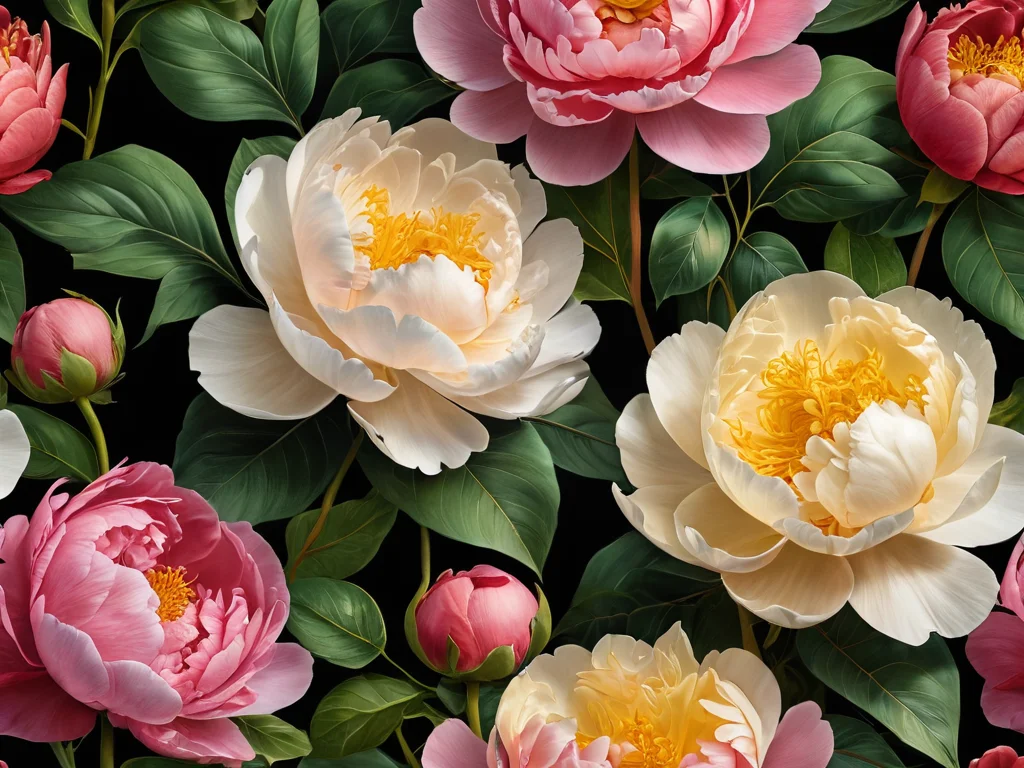
Each plant and flower in Feng Shui has its unique symbolism and carries a special energy. When choosing images for your home, it is crucial to understand what kind of energy you want to attract. Let’s look at the most popular and powerful symbols from the world of flora:
- Lotus (莲花 – liánhuā): This amazing flower, blooming from muddy water and remaining impeccably clean, is one of the most powerful symbols in Feng Shui. It embodies purity, spiritual enlightenment, perfection, love, and peace. Images of lotuses are ideal for areas related to meditation, solitude, and also for the bedroom, where they promote harmonious relationships and restful sleep. The lotus is believed to help purify the mind and attract spiritual wealth.
- Peony (牡丹 – mǔdān): Known as the “King of Flowers,” the peony is the embodiment of wealth, honor, high status, and romantic love. Its lush, luxurious petals symbolize prosperity and abundance. Images of peonies are especially favorable for the marriage area (Southwest) and the wealth area (Southeast). For unmarried women, peonies can accelerate meeting their soulmate, and for married couples, they can strengthen passion and love. However, caution should be exercised with an excess of peonies in the bedroom of a married couple, especially when the spouses are older, as the energy of peonies is too strong and can provoke “blooming” on the side.
- Orchid (兰花 – lánhuā): The elegant and exquisite orchid symbolizes fertility, abundance, luxury, refinement, as well as love and numerous offspring. It brings peace and harmony to the home, and also contributes to improving relationships and attracting luck. Images of orchids are perfect for the bedroom, living room, and areas related to creativity and children (West).
- Bamboo (竹 – zhú): This is a symbol of resilience, longevity, flexibility, prosperity, and rapid career advancement. Bamboo is known for its ability to grow quickly and adapt to any conditions, making it a powerful talisman for those seeking career growth and financial success. Images of bamboo are ideal for the career area (North) and the wealth area (Southeast). It is also believed to bring luck in studies and patronize knowledge.
- Chrysanthemum (菊花 – júhuā): This flower symbolizes joy, longevity, ease of being, and optimism. Chrysanthemums are associated with the sun and positive energy. They are ideal for public areas of the home, such as the living room or dining room, bringing happiness and well-being there. Images of chrysanthemums can improve mood and bring a sense of satisfaction.
- Blossoming Plum (梅花 – méihuā): A symbol of resilience, hope, purity, and beauty that blooms even in the cold season. Plum blossoms are also associated with nobility and endurance. Their images bring courage and determination, helping to overcome difficulties. Good for areas where support and willpower are needed.
- Peach (桃花 – táohuā): In Chinese culture, the peach is a symbol of immortality, health, protection from evil spirits, as well as love and marriage. Images of blooming peach trees or peach fruits can activate the energy of love and a long, happy life. Especially favorable for the marriage area (Southwest) and the health area (East).
- Pine (松 – sōng): Like bamboo, pine is a symbol of longevity, resilience, and strength. It retains its greenery even in winter, making it a symbol of steadfastness and constancy. Images of pine trees are good for the health and family area (East), bringing stability and well-being.
- Narcissus (水仙 – shuǐxiān): This flower is associated with good luck, talent, and wealth, especially in terms of career advancement. It is believed to help in developing abilities and bring success in business.
- Sunflower (向日葵 – xiàngrìkuí): The bright and cheerful sunflower symbolizes happiness, joy, longevity, and luck. It always reaches for the sun, attracting bright and positive energy. Images of sunflowers are perfect for the fame and recognition area (South), as well as for areas where you want to add more light and optimism.
By understanding the symbolism of each flower, you can approach the choice of images more consciously, directing energy to the areas of your life that you need.
Golden Feng Shui Rules: How to Properly Place Plant Images to Enhance Qi
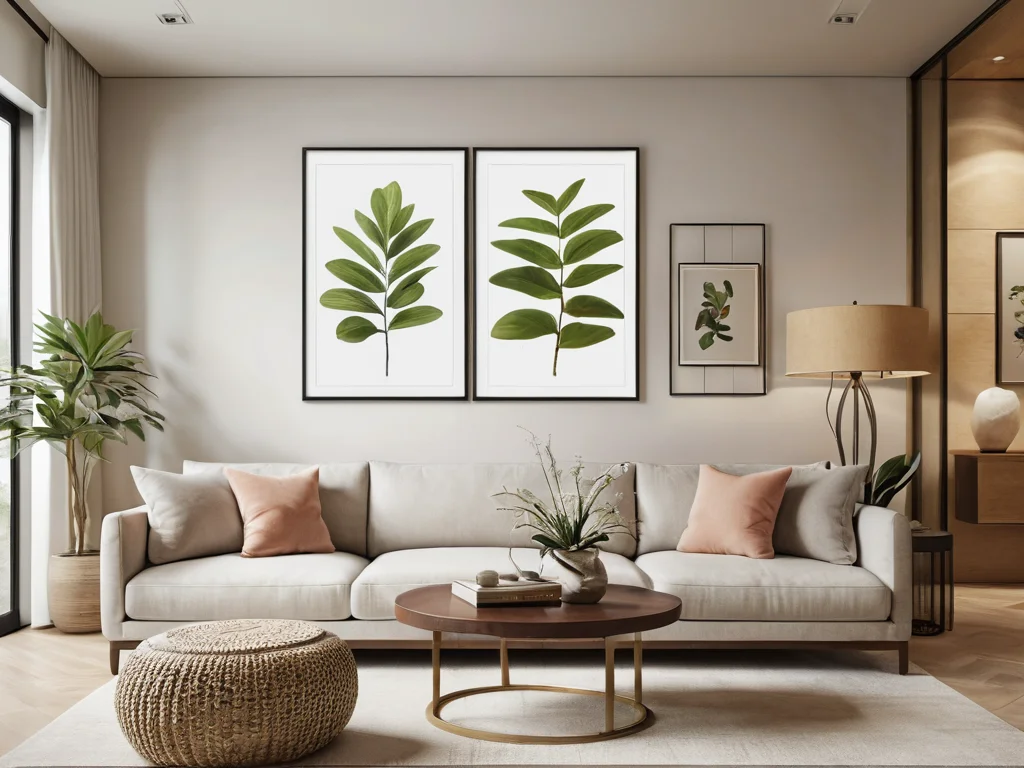
The correct placement of plant and flower images is no less important than their symbolism. After all, even the most powerful talisman can be useless or even harmful if placed incorrectly. Feng Shui masters highlight several key rules that will help you maximize the positive impact of these images:
- Avoid sharp corners and aggressive forms: It is believed that images with sharp, thorny plants (cacti, some types of agave) or abstract forms that appear aggressive create Sha Qi (negative energy). Instead, choose images with soft, rounded shapes and lush foliage that radiate calming and nurturing Sheng Qi energy.
- Place in well-lit and ventilated areas: Positive Qi energy loves light and movement. Paintings with flowers will work more effectively in places where natural light falls. If this is not possible, provide artificial lighting that favorably highlights the image. Avoid dark corners, closets, and places where energy stagnates.
- Consider scale and balance: The size of the image should correspond to the size of the room and wall. A too-small picture on a large wall will get lost, and a too-large one can overload the space and create a feeling of crampedness. Strive for visual balance so that the image harmoniously fits into the interior.
- Do not block Qi pathways: Avoid placing large, massive pictures directly opposite the entrance door or in narrow corridors where they can obstruct the free flow of energy. The goal is to create a smooth and harmonious flow of Qi throughout the house.
- Maintain cleanliness and good condition of images: Feng Shui emphasizes the importance of order and cleanliness. Dusty, faded, damaged, or outdated plant images bring negative energy. Regularly wipe frames and glass, and monitor the condition of the picture itself. If the image becomes unusable, it is better to replace it. This symbolizes renewal and the influx of new, fresh energy.
- Group wisely: Sometimes, several small images united by a common theme or color scheme can be more effective than one large one. Create compositions that look cohesive and harmonious.
- Avoid images of dead or wilting plants: Under no circumstances should you place images of dried bouquets, wilted flowers, or bare, lifeless trees (unless it is a specially stylized image carrying a positive meaning, such as a sakura tree in winter). They symbolize decline, stagnation, and lack of vitality, which can negatively affect the energy of the home.
By following these rules, you can transform images of plants and flowers from ordinary decor into powerful activators of positive energy, supporting harmony and prosperity in your home.
Bagua Guide: Ideal Plants and Flowers for Each Zone of Your Home

The Bagua map is one of the fundamental tools of Feng Shui, which helps divide space into nine life spheres, or zones. Each zone is associated with a specific aspect of your life, element, and color. Placing appropriate images of plants and flowers in these zones can significantly enhance the desired energy. Let’s go through each zone and find out which images will be most favorable:
- Career Zone (North): Water element, color blue/black. This zone is responsible for your professional path and life mission.
- Ideal: Images of bamboo, orchids, lotuses. Bamboo symbolizes rapid growth and flexibility in career. Orchids symbolize refinement and success. Lotus symbolizes purity of intentions and spiritual growth in profession.
- Why: These plants are associated with determination, development, and the ability to overcome obstacles, which is critically important for a successful career.
- Knowledge and Wisdom Zone (Northeast): Earth element, color beige/yellow/brown. This zone is related to self-improvement, learning, and spiritual development.
- Ideal: Images of lotuses, irises, chrysanthemums. Lotus promotes enlightenment and clarity of mind. Irises symbolize wisdom and inspiration. Chrysanthemums symbolize joy from acquiring new knowledge.
- Why: These flowers help to concentrate, develop intuition, and attract favorable opportunities for learning and self-development.
- Family and Health Zone (East): Wood element, color green. This is the heart of your home, responsible for family relationships, harmony, and physical well-being.
- Ideal: Images of pine, bamboo, lush greenery, blooming fruit trees. Pine and bamboo symbolize longevity and strong health. Lush greenery symbolizes family growth and development.
- Why: These images strengthen bonds, bring stability, harmony, and contribute to the overall healing of the home atmosphere.
- Wealth and Prosperity Zone (Southeast): Wood element, color purple/green. This zone is responsible for financial well-being and abundance in your life.
- Ideal: Images of peonies, lotuses, blooming fruit trees (e.g., cherry, peach), chrysanthemums. Peonies symbolize luxury and wealth. Lotus symbolizes abundance and purity. Fruit trees symbolize harvest and accumulation.
- Why: These flowers and plants attract financial luck, contribute to capital growth, and open new sources of income.
- Fame and Recognition Zone (South): Fire element, color red. This zone is related to your reputation, success, and public recognition.
- Ideal: Images of sunflowers, red peonies, bright flowers. Sunflowers symbolize brightness, joy, and attracting attention. Red peonies symbolize fame and high appreciation.
- Why: These images help you showcase your best qualities, become more noticeable, and receive deserved recognition for your talents and achievements.
- Marriage and Partnership Zone (Southwest): Earth element, color pink/yellow. This zone is responsible for romantic relationships, marriage, and partnership in all areas of life.
- Ideal: Paired images of peonies (especially pink), orchids, peach blossoms. Pairings are crucial here, symbolizing union.
- Why: Peonies attract love, orchids symbolize tenderness and fidelity, peaches symbolize a strong union and fertility. It is important to avoid single images.
- Children and Creativity Zone (West): Metal element, color white/silver. This zone is related to children, creative endeavors, and new ideas.
- Ideal: Images of white orchids, chrysanthemums, and delicate wildflowers. Orchids symbolize fertility and beauty. Chrysanthemums symbolize joy and lightness.
- Why: These flowers promote the development of creative potential, inspire new ideas, and support the well-being of children.
- Helpful People and Travel Zone (Northwest): Metal element, color gray/white. This zone is responsible for support, help from others, and the possibility of travel.
- Ideal: Images of white or pastel lotuses, delicate flowers symbolizing purity and lightness.
- Why: They attract patrons, help with travel, and provide support in difficult times.
- Center (Health and Harmony): Earth element, color yellow/brown. This is the heart of the entire home, which unites all other zones and is responsible for overall well-being.
- Ideal: Any balanced, healthy, and cheerful images of plants and flowers symbolizing prosperity and harmony. You can use images of a blooming garden or field.
- Why: Maintaining harmony in the center ensures well-being in all areas of life, so it is important to create the most positive and stabilizing atmosphere here.
By applying these recommendations, you can consciously fill each zone of your home with the corresponding energy, attracting the desired changes into your life.
Choosing with Wisdom: How Color, Style, and Material of an Image Affect Energy
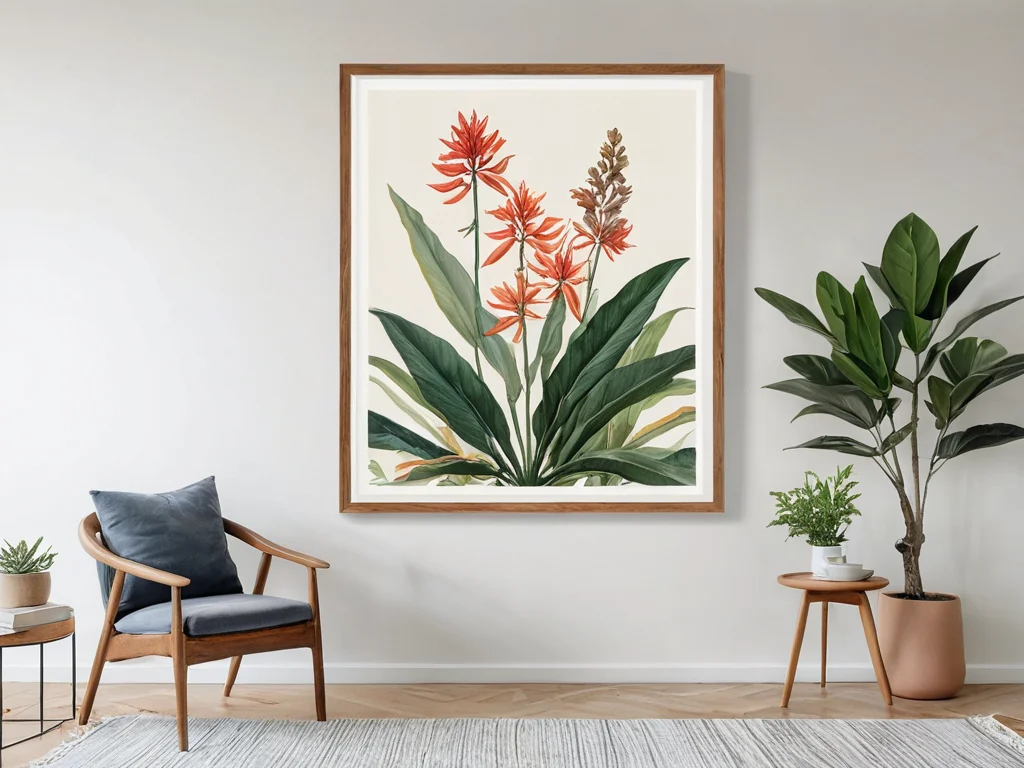
Choosing an image of a plant or flower is not just about its symbolism and placement. It is also important to consider the color, style of execution, and even the material from which the frame or base of the picture is made. These details carry their own energy and can either enhance or weaken the desired effect.
Influence of Color:
Color is a powerful energy carrier in Feng Shui. It can activate certain elements and bring corresponding qualities:
- Red: The color of passion, energy, fire, fame, and recognition. Images of red flowers (e.g., peonies, poppies, roses) are perfect for the South zone (Fame). It can add dynamism and brightness, but in excess, it can cause excitement or aggression, so use it in moderation.
- Green: The color of growth, health, renewal, the Wood element. Images of lush green foliage, bamboo, pine, young shoots are ideal for the East (Family/Health) and Southeast (Wealth) zones. It brings calmness, harmony, and promotes development.
- Yellow: The color of stability, earth, joy, the Earth element. Images of sunflowers, yellow chrysanthemums, wildflowers in yellow tones are good for the central zone (Health), Southwest (Marriage), and Northeast (Knowledge). Yellow creates a sense of coziness, warmth, and security.
- White/Silver: The color of purity, creativity, clarity, the Metal element. Images of white lotuses, orchids, narcissus are perfect for the West (Children/Creativity) and Northwest (Helpful People/Travel) zones. It brings freshness, new ideas, and clarity of thought.
- Blue/Black: The color of tranquility, wisdom, the Water element. Images of blue and purple flowers, as well as abstract images of aquatic plants, are suitable for the North zone (Career). They promote concentration, depth of thought, and career growth.
- Pink: The color of love, tenderness, romance. Especially important for the Southwest zone (Marriage). Pink peonies, roses, orchids in pink tones enhance the energy of love and harmony in relationships.
Style and Quality of the Image:
- Realistic Images: Often carry a stronger and more direct energy, as they are as close as possible to living nature. They can be very effective in creating a sense of the presence of real plants.
- Abstract and Stylized: Can carry a more subtle, but no less powerful energy, if their shapes and colors are chosen correctly. It is important that the image evokes pleasant, positive associations, rather than appearing chaotic or aggressive.
- Technique of Execution: Oil or watercolor paintings, photographs, embroidery – each technique has its unique texture and way of conveying energy. It is important that the image is executed with high quality and soul. Avoid faded, low-quality reproductions that can bring energy of decline.
- Mood of the Image: Choose pictures that evoke positive emotions in you – joy, calmness, inspiration. Avoid images that seem sad, gloomy, or make you feel depressed.
Framing Material:
The frame and mat also play a role, as they belong to specific elements:
- Wooden Frames: Ideal for the East (Family/Health) and Southeast (Wealth) zones, as they enhance the Wood element.
- Metal Frames (silver, gold, bronze): Suitable for the West (Children/Creativity) and Northwest (Helpful People/Travel) zones, corresponding to the Metal element.
- Glass Frames or Frameless (with water effect): Can be used in the North zone (Career), associated with the Water element.
- Ceramic or Clay Frames, as well as frames in warm, earthy shades: Favorable for the Southwest (Marriage), Northeast (Knowledge), and Central (Health) zones, belonging to the Earth element.
Remember that a harmonious combination of all these aspects – symbolism, color, style, and material – will allow you to fully unlock the potential of plant and flower images in your interior.
Practical Steps: 7 Key Tips for Integrating “Floral” Energy into Your Interior

Now that you are armed with knowledge about symbolism, placement, and elements, it’s time to apply these principles in practice. Integrating “floral” energy into your home is a fascinating and creative process. Here are seven practical steps to help you get started:
- Start with one significant detail: Don’t try to transform your entire home at once. Choose one zone or room where you feel the greatest need for energy improvement. Then, select one, but very significant for you, image that corresponds to the symbolism of this zone and your personal aspirations. For example, if you want to improve your relationships, start with a pair of peonies or orchids in the southwest part of the bedroom.
- Consider the room’s purpose: Each room in the house has its own specific energy and function.
- For the bedroom, choose calm, harmonious images that promote relaxation and love (orchids, lotuses, peach blossoms).
- For the living room, brighter, more cheerful images that promote communication and well-being are suitable (peonies, sunflowers, chrysanthemums).
- In a study or learning area, images that stimulate concentration and growth are preferred (bamboo, lotus).
- Choose images that you genuinely like: Feng Shui works through your energy and intentions. If you don’t like an image or it evokes mixed feelings, it won’t work effectively, even if it’s perfect according to all the rules. It is important that the chosen picture evokes joy, inspiration, and a sense of harmony in you.
- Ensure cleanliness and illumination: Remember that positive Qi loves cleanliness and light. Make sure the images are well-lit (by natural or artificial light) and regularly dust them. If a picture hangs in a dark corner, consider additional lighting.
- Vary shapes and textures: Don’t limit yourself to just paintings. Use prints on pillows, curtains, ceramic vases with floral ornaments, carved wooden panels with images of plants. Variety brings dynamism and multifacetedness to the energy of the space.
- Periodically refresh the decor: Energy should not stagnate. Once a year or as needed, review your images. Perhaps you’ll want to change their placement, add something new, or replace old pictures. This symbolizes renewal and the influx of fresh Qi into your life.
- Trust your intuition: Feng Shui is not only strict rules but also an art. Your intuition is a powerful tool. If you feel that a certain image is suitable for a specific place, even if it doesn’t 100% comply with all the canons, trust yourself. Your inner sense of harmony is of great importance.
By applying these tips, you can create not just a beautiful, but also an energetically strong interior that will support you in all areas of your life.
Avoid Disharmony: Common Mistakes and How to Fix Them When Working with Images

Using images of plants and flowers in Feng Shui is a powerful tool, but like any tool, it requires care and knowledge. Incorrect application can create disharmony instead of the desired harmony. Feng Shui masters often encounter typical mistakes that are easy to fix once you know about them.
Common Mistakes:
- Images of wilting or dead flowers: This is one of the most serious mistakes. Pictures with dried bouquets, fallen leaves, or wilting flowers symbolize decay, stagnation, decline, and even death. They can attract energy of sadness, disappointment, and illness.
- How to fix: Immediately remove such images from your home. Replace them with bright, fresh, vibrant images of blooming plants.
- Images of thorny or aggressive plants: Although some plants, like cacti, can be useful for absorbing electromagnetic radiation in an office, their images in living spaces, especially bedrooms, can create Sha Qi (aggressive energy). Thorny plants symbolize conflict, protection, but can also repel luck and harmony.
- How to fix: Avoid such images. If you really like them, place them in areas where strong protection is needed, for example, behind the entrance door (but not directly opposite), and make sure they are not directed at living areas. In general, smooth and soft shapes are preferable for home interiors.
- Overcrowding the space: Too many images, especially large and bright ones, can create chaos and energetic clutter. This can lead to a feeling of being overwhelmed, stressed, and unable to relax.
- How to fix: Strive for minimalism and balance. One or two well-placed images are better than ten chaotically hung ones. Let each image “breathe” and carry its energy.
- Incompatibility with the Bagua zone: Placing symbolism that contradicts the energy of the zone. For example, aggressive red peonies in the Knowledge zone (Northeast) or a single, gloomy flower in the Marriage zone (Southwest).
- How to fix: Carefully study the Bagua map and plant symbolism. Place images that harmonize with the energy of each specific zone. Always use paired images for the Marriage zone.
- Low quality or faded images: Images that look old, faded, worn, or are low-resolution emit energy of decline and deficiency.
- How to fix: Replace such images with high-quality, bright, and clear ones. This is an investment in the positive energy of your home.
- Images with water that appears stagnant or murky: If there is water in a picture with flowers, make sure it looks clean, clear, and flowing (e.g., a waterfall, a stream). Stagnant or dirty water symbolizes financial problems and stagnation.
- How to fix: Choose images where water symbolizes purity and flow.
- Images of aggressive or predatory plants: Although rare, sometimes images of predatory plants or those that appear threatening are encountered. They create negative energy.
- How to fix: Avoid them completely in living spaces.
Consciousness and attention to detail will help you avoid these mistakes and effectively use the power of plant and flower images to create a harmonious and prosperous space.
Your Home – A Blooming Garden: Create a Space of Prosperity and Joy Right Now!
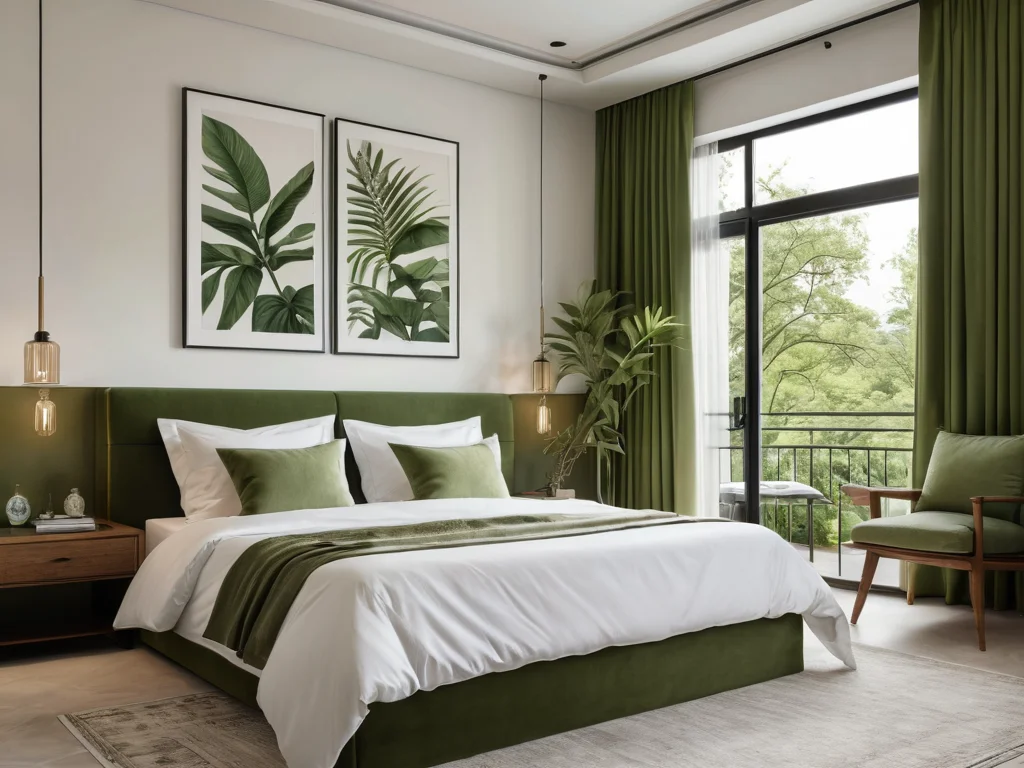
So, we have completed our fascinating journey into the world of Feng Shui, dedicated to the use of plant and flower images. You have learned how deep and multifaceted their influence is on the energy of your home and, consequently, on your life. From the ancient symbolism of the lotus to the cheerful sunflower, from strict placement rules to wise color choices – every aspect matters and can be the key to transformation.
Remember that your home is a reflection of your inner world and your aspirations. By creating a space around yourself filled with beauty, vitality, and harmony, you are inviting these qualities into your life. Images of plants and flowers are not just an aesthetic element; they are powerful energy activators that can inspire, calm, attract luck, and abundance.
Don’t postpone creating the space you dream of. Start right now: walk around your home with a new, conscious perspective. Where do you feel a lack of energy? Which area of your life needs support? Perhaps a pair of bright peonies in the wealth zone or calm bamboo in the career zone is exactly what you need for the first step.
Allow yourself to experiment, trust your intuition, and enjoy the process. When you surround yourself with images that symbolize growth, prosperity, and beauty, you set yourself up to receive these benefits. May every corner of your home become a blooming garden, filled with joy, well-being, and serenity. Feng Shui masters believe that it is precisely these details that create a truly happy life.
